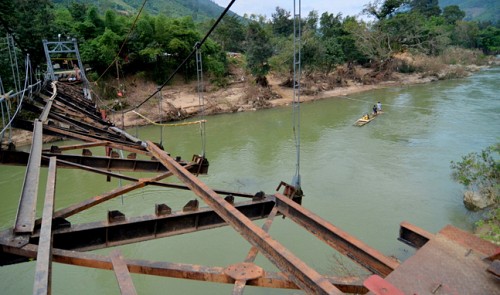Villagers across remote areas in Vietnam are risking their lives every day simply by crossing rivers, streams, or canals on their commutes, using their own dangerous ‘techniques.’ Here are some risky crossing ways in Kon Tum, Binh Dinh, Dien Bien, and even in the Vietnamese capital Hanoi.
SCROW DOWN FOR VIDEOS
Wrapping themselves in plastic bags
 A strong local man holds a female teacher in one hand and swims across Nam Po stream with the other. Photo by Tuoi Tre
A strong local man holds a female teacher in one hand and swims across Nam Po stream with the other. Photo by Tuoi Tre
People across Vietnam have been shocked to see a video clip showing teachers and students in Sam Lang village, located in the northern province of Dien Bien, getting across a fast-flowing stream by wrapping themselves in a plastic bag to be pulled from one bank to the other on their way to school. In the clip, female teachers and students were seen waiting for their turn to traverse Nam Po stream in the plastic bag. Local strong men were captured holding the bag’s mouth in one hand and swimming across the water with the other hand despite the powerful currents. There is a bridge over Nam Po stream but it is usually swept away by annual floodwater. The villagers said that every year the bridge is disassembled during flooding periods and it will be reconnected in the dry season. “It’s normal! That’s the only way to cross the stream because no bridge can stand floodwater,” local kindergarten teacher Tong Thi Minh, who shot the clip, told the newspaper. After the clip went viral, the Vietnamese Ministry of Transport said on Monday that they will build a suspension bridge in Sam Lang to ensure safety for locals.
Using a cable system
 A man and a boy in a village in Dak Nong Commune in the Central Highlands province of Kon Tum are pictured getting ready to cross a river using a cable with a pulley in May 2010. Photo by Tuoi Tre
A man and a boy in a village in Dak Nong Commune in the Central Highlands province of Kon Tum are pictured getting ready to cross a river using a cable with a pulley in May 2010. Photo by Tuoi Tre
Four years ago, people in a village in the Central Highlands province of Kon Tum had to go to school, workplaces and markets by sliding across a 150-meter-long cable with a pulley over a river as if they were modern Tarzans. According to various Tuoi Tre reports in May 2010, local residents in Dak Ang and Dak Nong Communes used this dangerous cable system, which was hung over 20 meters from the fast-flowing water of the river, for several months after a bridge had been swept away by floodwater. This crossing ‘tactic’ attracted a lot of media attention then. More than one month later, local authorities began the construction of a bridge in that area at a cost of VND1.5 billion (US$.71,000) sponsored by a Vietnamese businesswoman.
Rowing a raft

A man in a village in Binh Dinh Province risks his life as he tries to cross a river on a damaged bridge. Photo by Tuoi Tre

Children go to a primary school in the O5 village in Binh Dinh Province without life jackets. Photo by Tuoi Tre
About 260 families in several far-flung villages in the central province of Binh Dinh had to cross the swift-flowing waterway aboard a weak and small raft or even a badly-damaged bridge on their daily travels, as suspension bridges over the local section of the Kôn River connecting their accommodations to the outside world had collapsed, according to a Tuoi Tre report last December.
Many people were concerned that this could pose risks to local children since there were no life jackets or rescue equipment on the raft. A bridge connecting two banks of the river has been built in the area, according to local authorities.
Rowing boats with a rope

A man tugs a rope to move his raft with children and women onboard in Ngoc Lieu hamlet in this photo taken in April 2013. Photo by Tuoi Tre
Suffering the same fate as the Binh Dinh villagers were more than 500 people in Ngoc Lieu hamlet, a small riverside neighborhood in Hanoi’s outlying Thuong Tin District. They used a small boat covered in rust to ford a canal because there was no bridge, according to a Tuoi Tre article in April last year. The boat, which was the village’s only, had no engine so someone had to stand on it and tug a rope with its ends fixed on both banks to make the vehicle move across the canal. “The boat capsized several times and my two children and their textbooks got soaked in the water as a result. But thanks to God, they are alive because they were accompanied by adults,” said 36-year-old Nguyen Thi Man, a local resident. Local authorities said the construction of a bridge in the area would be completed in early 2014.





















































